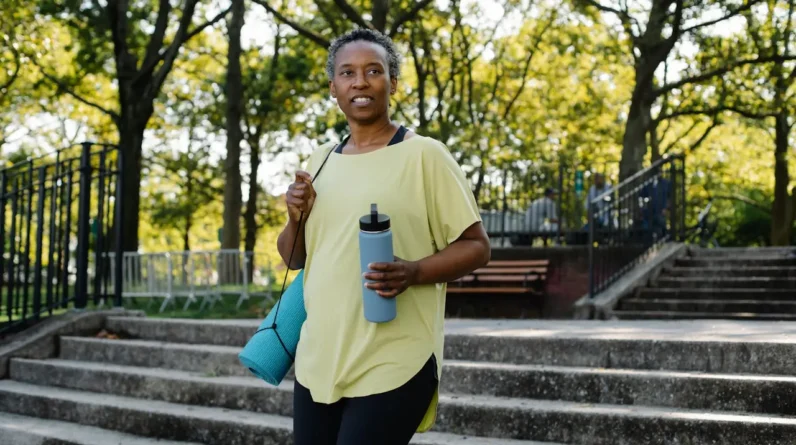
Maybe you’ve recently experienced this: You’re going about your usual routine when suddenly, climbing a flight of stairs leaves you breathless, or reaching for something on a high shelf causes unexpected discomfort.
It dawns on you that you haven’t exactly taken care of your physical body in some time… No shame here! It happens.
But we all know that our physical wellness is important for overall wellness and health. In fact, when our physical wellness suffers, so can our mental and emotional health.
While we might spend hours scrolling through social media or planning our next career move, many of us neglect this fundamental pillar of overall health and well-being. And it’s not entirely your fault; society has become based around making things physically easy.
For instance, many of us sit most of the day for work. Escalators and elevators also add ease when shopping or heading into the office. Food delivery has made getting groceries or meals that much easier. And while these are good things, it’s not exactly supporting our physical wellness in the best way possible.
From how we fuel our bodies to how we move and rest, every aspect of our physical health plays a crucial role in shaping our energy levels, daily performance, and long-term vitality.
- So, how can you improve your physical wellness?
- What does “physical wellness” mean anyway?
What is the Meaning of Physical Wellness?
Hippocrates once said, “Walking is man’s best medicine.” And this ancient wisdom still rings true today.
After all, we are biological beings first and foremost. Our bodies offer the foundations for everything we do—from pursuing our passions to connecting with loved ones, achieving our goals, and simply enjoying life’s pleasures. Ultimately, our physical being allows us to interact with the world.
So, what does physical wellness encompass exactly?
Physical wellness, also known as physical health or physical fitness, includes:
- Regular physical activity and movement
- Proper nutrition and hydration
- Adequate sleep and rest
- Prevention of illness and injury
- Maintaining healthy body systems
- Physical strength and endurance
- Flexibility and balance
But it’s important to note that physical wellness isn’t about having a perfect body or achieving elite athlete status. Life presents various physical demands, and we need to be prepared to meet them. Not only that, but maintaining physical wellness across our lifespan can ensure we live a full and vibrant life, no matter our age!
By developing greater physical wellness, we can participate in all the activities we enjoy. We can chase after our grandkids as we get older. We can move without pain. Generally, it impacts all parts of our life.
So, what kind of goals should we think about in relation to physical wellness?
What Are Good Physical Wellness Goals?
Setting physical wellness goals doesn’t require expensive gym memberships or extreme diet changes. Instead, focus on small and achievable targets such as:
- Establish a consistent sleep schedule
- Increase daily water intake
- Add more whole foods to your diet
- Build a regular exercise routine
- Improve posture and body awareness
- Schedule regular health check-ups
- Reduce sedentary time
- Practice proper injury prevention
Your exact personal goals will depend on your current physical condition and areas where you want to improve.
- Where do you feel most limited in your daily activities?
- What aspects of your physical health concern you most?
- Do you have certain diseases or conditions that need to be addressed?
For instance, if you find you feel constantly drained of energy, your goal might be to develop three new sleep hygiene practices and maintain them consistently over the next month, like:
- going to bed at the same time
- avoiding screens an hour before bed
- developing a relaxing bedtime routine
Or perhaps you might try to clean up your diet, such as eating 80% whole foods; after all, food matters for energy, too!
How Do I Improve My Physical Wellness?
Here are some more specific ways to improve your physical wellness and health; keep in mind that consistency is key for our physical well-being. Creating habits that last are important!
So, where can you get started here?
1. Practice Mindfulness
Start by simply noticing how your body feels during your different daily activities.
- How did that recent lunch sit?
- Did that yoga class feel good afterward?
Consider keeping a movement journal where you track your physical activities, diet, and energy levels. This practice can help you understand your body’s patterns and responses better.
Remember that all forms of movement count, from taking the stairs to dancing in your kitchen. By tuning into how you feel when you move a certain way or eat certain foods, you can gain a better understanding of what your body needs.
This can also help harness you to the present moment, which has mental health benefits, too!
Related Article: Can Juicing Boost Your Health? Top 10 Benefits for Mental & Physical Health
2. Create a Healthy Movement Routine
Exercise doesn’t have to mean punishment nor does it have to mean following unsustainable workout plans. Instead, opt to build a toolkit of enjoyable physical activities—ones you can turn to when you lack motivation.
For example, dance offers an enjoyable and fun way to move without any pressure! Or cycling to work is an easy addition, if available to you. You can also choose to get friends or family involved; make it a social event! Attend classes together. Go for hikes to catch up. There are so many options here.
The key is to find something you love and develop a routine around it. Even gardening can be a wonderful activity to move your body and get outside.
3. Know Rest is Important
In our fast-paced world, rest often gets labeled as mere laziness. However, understanding and honoring your body’s need for recovery is essential for physical wellness. It’s not just about moving!
Think about it: Even the most sophisticated machines need downtime for maintenance and repair. Your body is no different! Just as you wouldn’t expect your phone to run indefinitely without recharging, your body requires regular periods of rest to function optimally.
Rest takes many forms.
There’s passive rest, like sleep and relaxation, which allows your body to repair tissues and restore energy.
Then, there’s active recovery, such as gentle stretching or light walking, which helps maintain mobility while giving your body a break from more intense activities.
Pay attention to signs that your body needs rest, such as:
- Persistent fatigue or decreased performance
- Unusual muscle soreness
- Changes in sleep patterns
- Decreased motivation
- Increased irritability
- Slower recovery between activities
Remember that rest isn’t just about physical recovery—it’s an investment in your future performance and well-being.
When you honor your body’s need for rest, you’re more likely to maintain consistent activity levels and avoid the setbacks that come with overtraining or exhaustion.
4. Build Consistent Habits
Physical wellness requires various lifestyle habits.
In other words, it’s not just about movement. But it’s also not just about diet, either.
So, what does this mean?
- You could focus on improving your nutrition by planning balanced meals and staying hydrated.
- Consider establishing consistent sleep patterns that allow for adequate rest and recovery.
- You might also create an environment that supports physical activity, whether that means keeping exercise equipment visible or making your favorite walking routes easily accessible.
And don’t hesitate to seek professional guidance when needed; sometimes, working with a trainer, physical therapist, or healthcare provider can provide valuable direction!
Related Article: The Rise of Energy Healing Therapies: Beyond Traditional Medicine
5. Practice Body Acceptance
Many of us struggle with unrealistic physical expectations.
The truth is that every body is different, with unique needs and capabilities. And those “ideals,” well, they rarely exist in the real world (and are often thanks to good ol’ Photoshop!). So, let’s start by acknowledging your body’s current state while working toward realistic improvements.
Consider focusing on how your body feels and what it can do rather than how it looks.
For instance, focusing on strength over looking “toned” can help you achieve much more and feel much better about yourself and your body! And, in turn, this can help foster a more positive and productive relationship with physical activity and health.
Nurture Your Physical Temple & Build Your Physical Wellness, One Step at a Time!
Think of your body as your lifelong home.
Regular maintenance and thoughtful improvements will help it serve you well throughout your journey. It’s not a race, nor should it be. Instead, think about how you can nurture your home (your body) in the best way possible; this can help guide you to make the best choices in your life to achieve better physical wellness and health!
And keep in mind that small steps are better than none at all.
Slow and steady wins the race!
- So, what aspects of your physical wellness could use some attention?
- How might improving your physical health positively impact other areas of your life?
Your journey begins here and now.
Read Next: 6 Different Types of Self-Care and How You Can Practice Them
Photo by Liliana Drew







